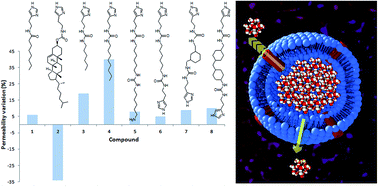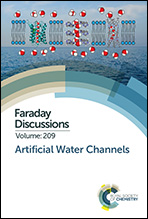Imidazole derivatives as artificial water channel building-blocks: structural design influence on water permeability
Abstract
A series of mono- and di-ureidoethylimidazole derivatives were tested as self-assembled supramolecular channels for water transport. Several structural behaviours were compared in order to gain insight on the structure–water transport activity relationship. The three main features that are critical to tailor artificial water channel building blocks are: (i) the selectivity of the hydrophilic head, (ii) the H-bonding scaffold favouring the directional self-assembly, and (iii) the lipophilic tail for the compatibility with the hydrophobic environment of the lipid bilayer. The designed compounds bear one or two imidazole heads, one or two urea moieties, and different lipophilic tails. Water transport experiments were performed in order to assess the critical parameters. For that, large unilamellar vesicles (LUV) were fabricated using a mixture of phosphatidylcholine, phosphatidylserine and cholesterol. The bilayer of the LUV constituted a membrane between an intra and an extra vesicular medium. The artificial water channel candidates are put in the presence of this membrane to improve its water permeability. The permeation of elements other than water is ideally maintained to a minimum in order to achieve selective water filtration. In this study the effect of additional urea moieties, as well as its absence, was evidenced as detrimental for the permeation and the influence of the tail was also investigated.

- This article is part of the themed collection: Artificial Water Channels


 Please wait while we load your content...
Please wait while we load your content...